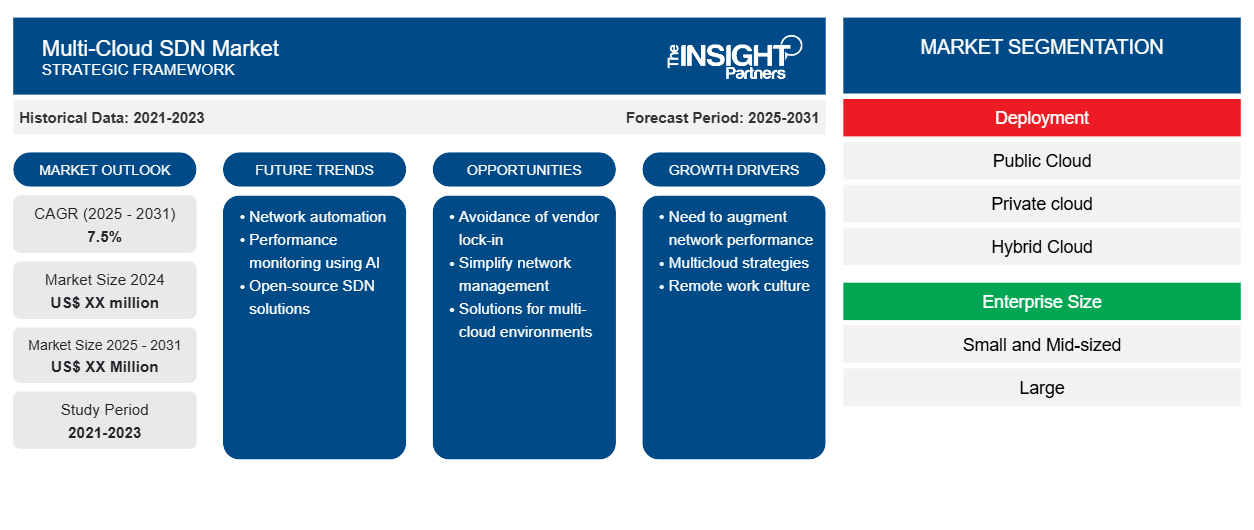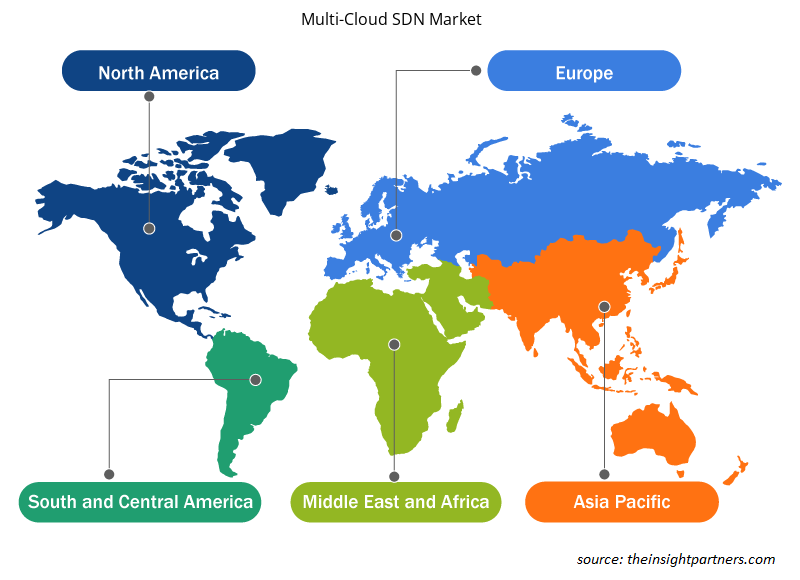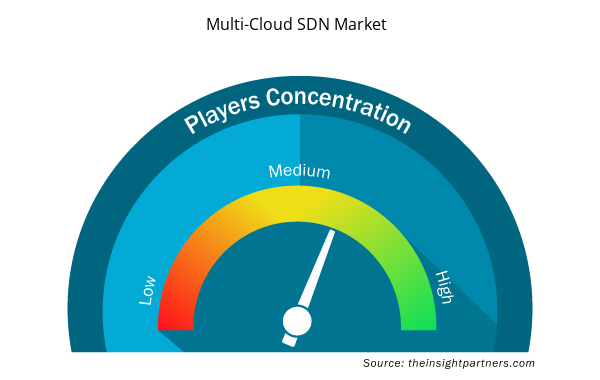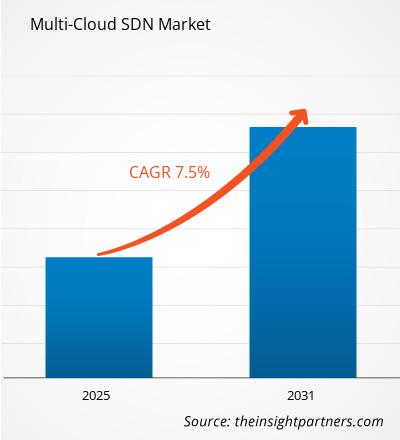The Multi-Cloud SDN Market is expected to register a CAGR of 7.5% from 2025 to 2031, with a market size expanding from US$ XX million in 2024 to US$ XX Million by 2031.
Multi-Cloud SDN Market is Segmented into deployment model, enterprise size, end-user industries, and by region, the report presents an in-depth analytical overview of the Multi-Cloud SDN Market. In this systematic study, stakeholders will get a panoramic view of the dynamic rise of the market across main regions/countries.
All assessment in the report is in US dollars, hence providing a clear understanding of market dynamics, growth trends, and competitive landscapes for various segments. It underlines how strategic shift driven by the increasing adoption of SDN across multi-cloud environments is changing the operational efficiencies, adding scalability, and innovating at scale.
Indeed, comprehensive information about technological advancement, regulatory issues, and emerging trends helps stakeholders to understand how to find the right opportunity and make apt decisions in the rapidly changing multi-cloud SDN market. The report wraps up on the essential elements of strategic planning and adaptability needed in the light of emerging complexities of cloud integration and management that enable organizations to realize effectively the power of SDN in optimizing their respective multi-cloud strategy.
Purpose of the Report
The report Multi-Cloud SDN Market by The Insight Partners aims to describe the present landscape and future growth, top driving factors, challenges, and opportunities. This will provide insights to various business stakeholders, such as:
- Technology Providers/Manufacturers: To understand the evolving market dynamics and know the potential growth opportunities, enabling them to make informed strategic decisions.
- Investors: To conduct a comprehensive trend analysis regarding the market growth rate, market financial projections, and opportunities that exist across the value chain.
- Regulatory bodies: To regulate policies and police activities in the market with the aim of minimizing abuse, preserving investor trust and confidence, and upholding the integrity and stability of the market.
Multi-Cloud SDN Market Segmentation
Deployment
- Public Cloud
- Private cloud
- Hybrid Cloud
Enterprise Size
- Small and Mid-sized
- Large
End User
- BFSI
- IT and Telecommunications
- Manufacturing
- Transportation and Logistics
- Defense and Government
- Healthcare
- Retail
- Energy and Utilities
Geography
- North America
- Europe
- Asia-Pacific
- South and Central America
- Middle East and Africa
Customize This Report To Suit Your Requirement
You will get customization on any report - free of charge - including parts of this report, or country-level analysis, Excel Data pack, as well as avail great offers and discounts for start-ups & universities
Multi-Cloud SDN Market: Strategic Insights

- Get Top Key Market Trends of this report.This FREE sample will include data analysis, ranging from market trends to estimates and forecasts.
Multi-Cloud SDN Market Growth Drivers
- Need to augment network performance: The rise in the need to augment network performance while improving the efficiency in all cloud ecosystems creates luring opportunities for the Multi-Cloud Software-Defined Networking market.
- Multicloud strategies: Multicloud strategies are adopted by companies in order to gain flexibility, mitigate the risk of vendor lock-in as well to ensure optimal demand of SDN solutions to provide a seamless-connectivity across a wide variety of cloud platforms.
- Remote work culture: Surge in work-from-home culture and digital transformation initiatives encourage firms to making investments in cost and scalable network solutions that are more secure.
- Rising security regulations: Rising security regulations are subsequently pressuring enterprises to adopt SDN technologies that help to achieve improved control and visibility over the network infrastructure.Trends - Network automation and orchestration, better management of the multi-cloud environments are the current trends. AI and ML are also very much important as these tools make the network being optimized much better and the performance monitoring superb. Meanwhile, edge computing nowadays in this modern era is changing the SDN scenario with more emphasis given to compute and process data in places close to the data source where the network latency is improved. Most organizations are looking at how to process data in close proximity to the point of origin, and this is due to the reason that organizations of today rely on the latency of their networks to improve service delivery. Networks are becoming open source based SDN solutions so more flexibility to organisations in terms of network cost would manage their organisation networks. Increased Interoperability between a variety of cloud providers further leads to collaboration between these organizations to improve service delivery.Ultra-Thin Solar Cell Market Drivers: One of the primary factors contributing to the growth of the Ultra-Thin Solar Cell market is the rising demand for more efficient and lighter weight solar energy solutions. Because of the improvement in solar system technology, ultra-thin solar cells can be designed to have a more efficient and flexible photovoltaic material, making it suitable for electronics, solar panels, space applications, portable electronics, building-integrated photovoltaics and everything in between. This has all been fostered by the current trend of shifting to renewable energy sources and the world's green agenda. Governments take initiatives to encourage the use of solar energy by providing incentives and regulations. This increases interest in investing in ultra-thin solar technologies due to their immunity to changing weather conditions. With the continual price decrease in material and manufacturing process of solar cells for panels, applications will become more economical to consumers.
Multi-Cloud SDN Market Future Trends
- Network automation: The megatrends in Multi-Cloud SDN are all about more emphasis on network automation and orchestration through which multiple different vendors’ networks can be better managed.
- Performance monitoring using AI: Artificial Intelligence (AI) and Machine Learning are making network optimization and performance monitoring better now. As a side note, Edge Computing in the contemporary context is also impacting the strategy for SDN, and enterprises nowadays are trying to process the data as close to the source, as data being processed near the source gives a better outcome in terms of improved latency.
- Open-source SDN solutions: The enterprises are focusing on supplier independence of multiple cloud vendors - this leads to more collaboration to improve the quality of service delivery. There is an increasing trend of open-source SDN solutions, as this gives more flexibility and cost-efficiency to the enterprises who are in need of such infrastructure.
Multi-Cloud SDN Market Opportunities
- Avoidance of vendor lock-in: With multi-cloud SDN solutions, enterprises will have better network flexibility and scalability, which seamlessly connect diverse cloud environments. Besides, it seriously improves operational efficiency, while the avoidance of vendor lock-in becomes a major problem for many organizations.
- Simplify network management: The service providers will be in a position to take advantage of the growing demand for managed SDN services by offering solutions that could simplify network management and improve security across a set of multiple clouds. New business opportunities and improved network performance have resulted from integrating AI and machine learning with SDN technologies. Additionally, automating administrative chores might result in a 30% reduction in operating costs, further boosting the growth of the multi-cloud SDN market share.
- Solutions for multi-cloud environments: Network equipment manufacturers can provide new hardware and software solution offerings for multi-cloud environments while embedding features that specifically address enterprise transition to cloud-based infrastructures. Rising investment in security solutions by companies in order to prepare for any cyber situations may impact on market share and multi-cloud SDN market growth.
Multi-Cloud SDN Market Regional Insights
The regional trends and factors influencing the Multi-Cloud SDN Market throughout the forecast period have been thoroughly explained by the analysts at Insight Partners. This section also discusses Multi-Cloud SDN Market segments and geography across North America, Europe, Asia Pacific, Middle East and Africa, and South and Central America.

- Get the Regional Specific Data for Multi-Cloud SDN Market
Multi-Cloud SDN Market Report Scope
| Report Attribute | Details |
|---|---|
| Market size in 2024 | US$ XX million |
| Market Size by 2031 | US$ XX Million |
| Global CAGR (2025 - 2031) | 7.5% |
| Historical Data | 2021-2023 |
| Forecast period | 2025-2031 |
| Segments Covered |
By Deployment
|
| Regions and Countries Covered | North America
|
| Market leaders and key company profiles |
Multi-Cloud SDN Market Players Density: Understanding Its Impact on Business Dynamics
The Multi-Cloud SDN Market market is growing rapidly, driven by increasing end-user demand due to factors such as evolving consumer preferences, technological advancements, and greater awareness of the product's benefits. As demand rises, businesses are expanding their offerings, innovating to meet consumer needs, and capitalizing on emerging trends, which further fuels market growth.
Market players density refers to the distribution of firms or companies operating within a particular market or industry. It indicates how many competitors (market players) are present in a given market space relative to its size or total market value.
Major Companies operating in the Multi-Cloud SDN Market are:
- Amazon Web Services Inc.
- VMware, Inc.
- Hewlett Packard Enterprise Inc.
- Dell Inc.
- Oracle Corporation Inc.
Disclaimer: The companies listed above are not ranked in any particular order.

- Get the Multi-Cloud SDN Market top key players overview
Key Selling Points
- Comprehensive Coverage: The report comprehensively covers the analysis of products, services, types, and end users of the Multi-Cloud SDN Market, providing a holistic landscape.
- Expert Analysis: The report is compiled based on the in-depth understanding of industry experts and analysts.
- Up-to-date Information: The report assures business relevance due to its coverage of recent information and data trends.
- Customization Options: This report can be customized to cater to specific client requirements and suit the business strategies aptly.
The research report on the Multi-Cloud SDN Market can, therefore, help spearhead the trail of decoding and understanding the industry scenario and growth prospects. Although there can be a few valid concerns, the overall benefits of this report tend to outweigh the disadvantages.
- Historical Analysis (2 Years), Base Year, Forecast (7 Years) with CAGR
- PEST and SWOT Analysis
- Market Size Value / Volume - Global, Regional, Country
- Industry and Competitive Landscape
- Excel Dataset


- Adaptive Traffic Control System Market
- Joint Pain Injection Market
- Industrial Inkjet Printers Market
- Integrated Platform Management System Market
- Truck Refrigeration Market
- Mobile Phone Insurance Market
- Photo Editing Software Market
- Microplate Reader Market
- Redistribution Layer Material Market
- Artificial Turf Market

Report Coverage
Revenue forecast, Company Analysis, Industry landscape, Growth factors, and Trends

Segment Covered
This text is related
to segments covered.

Regional Scope
North America, Europe, Asia Pacific, Middle East & Africa, South & Central America

Country Scope
This text is related
to country scope.
Frequently Asked Questions
The report can be delivered in PDF/PPT format; we can also share excel dataset based on the request.
Some of the customization options available based on request are additional 3-5 company profiles and country-specific analysis of 3-5 countries of your choice. Customizations are to be requested/discussed before making final order confirmation, as our team would review the same and check the feasibility.
Key players in this market are - Amazon Web Services Inc., VMware, Inc., Hewlett Packard Enterprise Inc., Dell Inc., Oracle Corporation Inc., IBM Corp., Microsoft, Cisco Systems, Inc., Huawei Inc., Fujitsu
The market is expected to register a CAGR of 7.5% during 2023-2031
The driving factors for the Multi-Cloud SDN market include increased flexibility, scalability, and optimization of costs for cloud services. Organizations are moving toward multi-cloud strategies to avoid vendor lock-in and hence assure better performance, driving up the demand for the deployment of SDN solutions.
Future trends focus on automation and orchestration to simplify multi-cloud management. Enhanced security features will become critical as organizations adopt multi-cloud architectures. Additionally, the integration of AI for network optimization and monitoring will significantly enhance operational efficiency and responsiveness.
Trends and growth analysis reports related to Technology, Media and Telecommunications : READ MORE..
1.Amazon Web Services Inc.
2.VMware, Inc.
3.Hewlett Packard Enterprise Inc.
4.Dell Inc.
5.Oracle Corporation Inc.
6.IBM Corp.
7.Microsoft
8.Cisco Systems, Inc.
9.Huawei Inc.
10.Fujitsu

 Get Free Sample For
Get Free Sample For